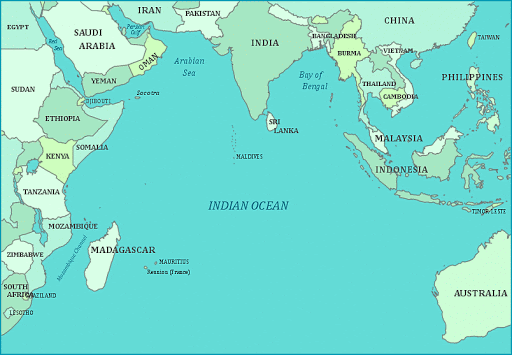Science & Technology
Genome Mapping in Indian Ocean
- 13 Mar 2021
- 7 min read
Why in News
National Institute of Oceanography (NIO) is going to launch the first-of-its-kind project of Genome Mapping in the Indian Ocean.
- Indian Ocean is the third largest water body in the world, covering about 20% of the Earth’s water surface.
Key Points
- Aim:
- To gather samples for genome mapping of microorganisms in the Indian Ocean.
- To understand the biochemistry and the response of the ocean to climate change, nutrient stress and increasing pollution.
- Project Cost & Duration:
- Rs. 25 crore and will take three years to complete.
- About:
- A team of scientists and researchers from the NIO on board its research vessel Sindhu Sadhana will spend 90 days traversing the course of over 10,000 nautical miles in the Indian Ocean on the research project to reveal the internal working of the body of the ocean at a cellular level.
- They will course the Indian Ocean from India’s east coast, Australia, Port Louis in Mauritius and up to the border of Pakistan, off India’s west coast.
- A team of scientists and researchers from the NIO on board its research vessel Sindhu Sadhana will spend 90 days traversing the course of over 10,000 nautical miles in the Indian Ocean on the research project to reveal the internal working of the body of the ocean at a cellular level.
- Genome Collection:
- The researchers will collect samples from various stretches of the ocean at an average depth of about 5 km.
- Just like gene mapping is carried out on blood samples collected from humans, the scientists will map these in the bacteria, microbes found in the ocean.
- The mapping of the Deoxyribose Nucleic Acid (DNA) and Ribonucleic Acid (RNA) will show the nutrients present in them, and also those lacking in different parts of the ocean.
- Studying Trace Elements:
- Trace metals like cadmium or copper are supplied to oceans via continental run-offs, atmospheric deposition, hydrothermal activities and continental shelf interaction.
- They are essential for ocean productivity.
- It is important to understand the interactions of trace metals with marine biota “for having a holistic understanding about nutrient cycling and productivity of the oceans”.
- Apart from their reactions on marine life, isotopic forms of trace metals can be utilised to track the movement of water masses responsible for ocean circulation and as tools to study the biological, geochemical and ecosystem processes and food web analyse.
- The NIO’s project is expected to generate new information about trace metals from underexplored regions of the Indian Ocean.
- Trace metals like cadmium or copper are supplied to oceans via continental run-offs, atmospheric deposition, hydrothermal activities and continental shelf interaction.
- Benefits:
- Understanding Ecosystem:
- It will help scientists understand the internal working of the ecosystem of the Indian Ocean.
- Understanding Factors Causing Change:
- The research will enable scientists to identify the factors controlling the changes in RNA, DNA in the oceans, and various stressors impacting them.
- Identifying Mineral Concentration:
- The ocean has several micronutrients like nitrates, sulphates and silicates, minerals like iron ore and zinc, and trace metals like cadmium or copper.
- The genome mapping will show the presence of which these microbes have adapted to, in addition to their reaction to atmospheric carbon dioxide.
- This will help in identifying which part of the ocean has a greater concentration of which mineral or element.
- Scientists will then use these as tracers to tackle the causative factors for excess or lack of a certain mineral or element and suggest possible solutions for their mitigation.
- Human Benefit:
- The large pool of RNA, DNA library of the oceans will be utilised for using the Indian Ocean to human benefit in the future.
- Increased Biotechnology Application:
- Genome mapping will enable an increase in the growing number of commercial biotechnology applications, extending from multiple anticancer treatments to cosmetics and industrial enzymes, to antiviral molecules.
- Optimization of Conservation Efforts:
- Exploration of the ocean at a genetic level will result in new insights into taxonomy and adaptive capacity that can help optimize conservation efforts.
- Understanding Ecosystem:
Genome
- A genome is the complete set of DNA (or RNA in RNA viruses) of an organism.
- Each genome contains all of the information needed to build and maintain that organism.
- In humans, a copy of the entire genome contains more than 3 billion DNA base pairs.
Genome Mapping
- It describes the methods used to identify the locus of a gene and the distances between genes. Gene mapping can also describe the distances between different sites within a gene.
- Taking inspiration from the Human Genome Project, the Department of Biotechnology (DBT) initiated the ambitious “Genome India Project” (GIP) in January 2020. The GIP aims to collect 10,000 genetic samples from citizens across India, to build a reference genome.
National Institute of Oceanography
- About:
- It is a multi-disciplinary oceanographic research institute and is one of the constituent laboratories of the Council of Scientific & Industrial Research (CSIR), New Delhi.
- Headquarter and Other Centres:
- Its headquarters is at Dona Paula, Goa with regional centres at Kochi (Kerala), Mumbai (Maharashtra) and Visakhapatnam (Andhra Pradesh).
- Established:
- It was established on 1st January 1966 following the International Indian Ocean Expedition (IIOE) in the 1960s.
- Research Areas:
- The principal focus of research has been on observing and understanding special oceanographic characteristics of the Indian Ocean.
- The major research areas include the four traditional branches of oceanography - biological, chemical, geological/geophysical and physical, as well as ocean engineering, marine instrumentation and marine archaeology.







